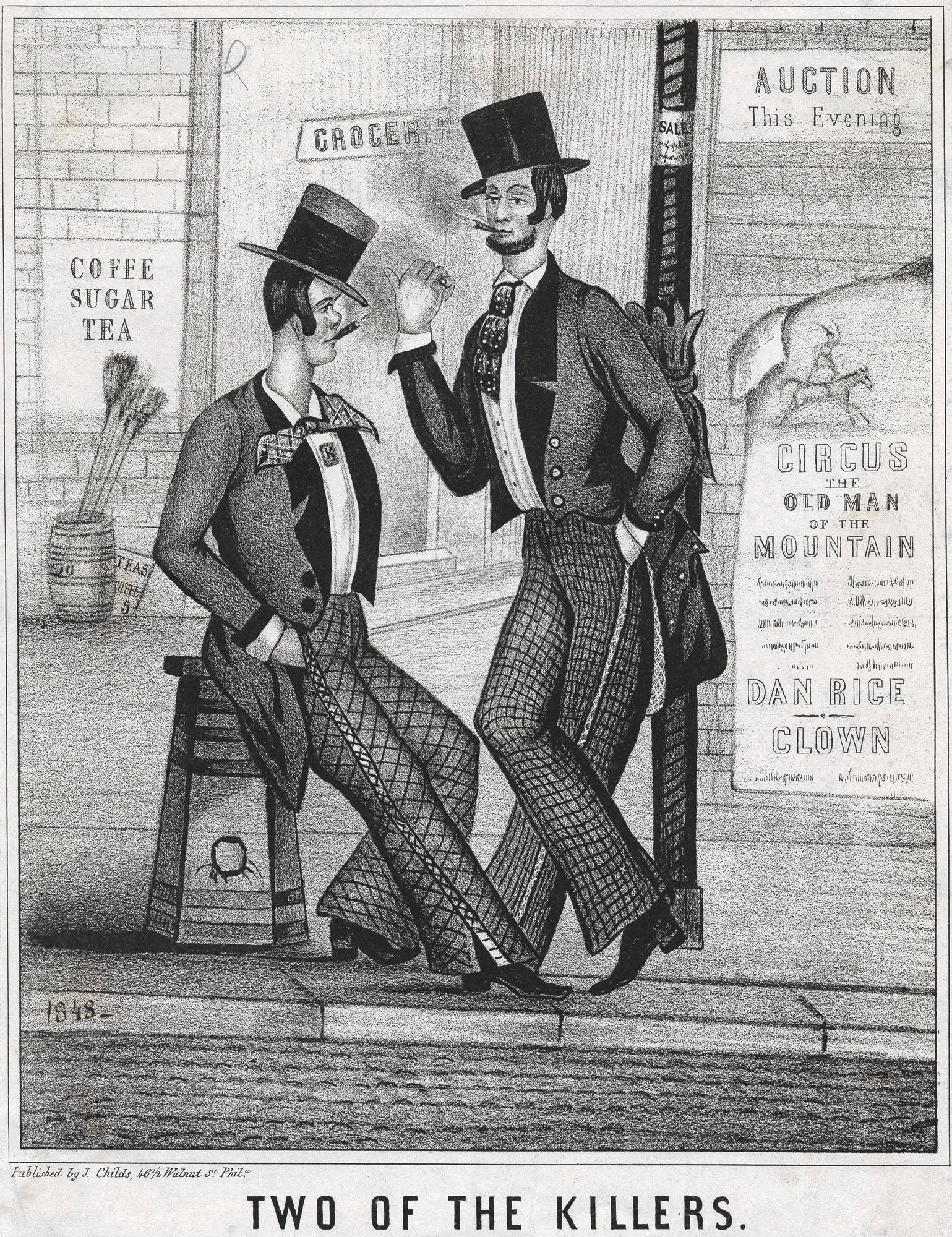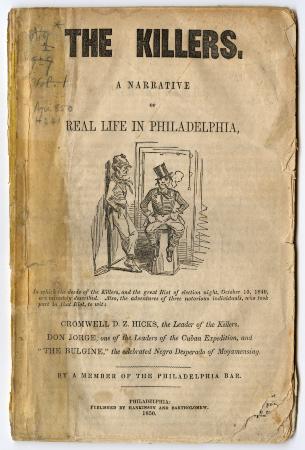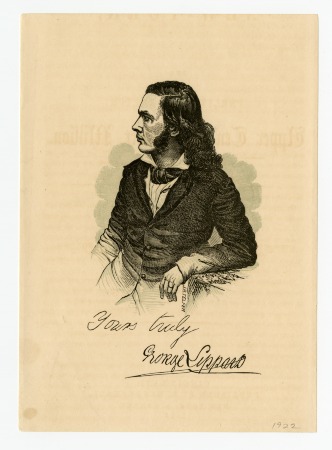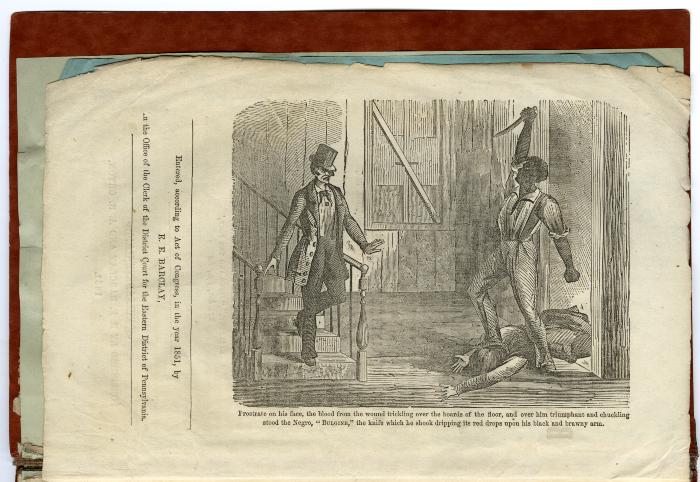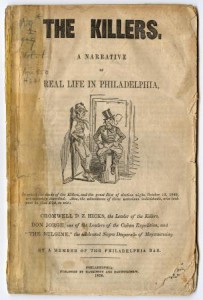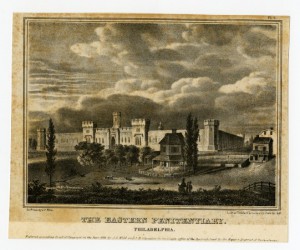Killers (The): A Narrative of Real Life in Philadelphia
By Matt Cohen
Essay
The Killers is a sensational urban gothic tale written by the journalist, novelist, and labor activist George Lippard (1822-54) in 1849. It exposes Philadelphia’s class and racial conflicts and its gang warfare, criticizes corruption in government and finance, and lambasts the city’s new experiment in incarceration, the solitary confinement system of Eastern State Penitentiary. Illustrated by the well-known artist Felix Octavius Carr Darley (1822-88), The Killers dramatizes and politicizes the social transformations overtaking the city in an age of mass immigration, industrialization, financial instability, and growing tensions over race and slavery.

By the time he wrote The Killers, Lippard was famous for the 1844 publication of another urban gothic novel, The Quaker City; or, Monks of Monk Hall, which was among the best-selling American novels before Harriet Beecher Stowe’s (1811-96) Uncle Tom’s Cabin. In The Killers, one of many “city mysteries” inspired by the rapid expansion of urban areas and by French writer Eugène Sue’s (1804-57) Mysteries of Paris (1842-43), Lippard depicts the disintegration of the family of Jacob D.Z. Hicks, a wealthy Philadelphia merchant. Hicks’s illegitimate but pampered son Cromwell is disowned by his father thanks to his own profligacy and his mother’s leaving his father. Hicks’s wife, as she dumps him for an English baronet, reveals that his real son, Elijah, had been raised in a poor family (with Kate Watson, whom Elijah considers his true sister). Elijah is imprisoned in Eastern State Penitentiary for four years for passing a false note on a bank Hicks owns. When he discovers that Hicks is his true father, Elijah vows revenge for his abandonment, and to get it, eventually joins the notorious South Philadelphia gang “The Killers.” By that time, the disowned Cromwell is the leader of the gang.
The California House Riot, which began on October 9, 1849 (election night that year), served as the real-life inspiration for the story. The California House, in the African American neighborhood around Sixth and St. Mary Streets, was a business owned by a Black man who had been rumored to be married to a white woman. It became the epicenter of a violent riot involving local African American residents, working-class Irish gangs, fire hose companies, and the city’s police and militia.
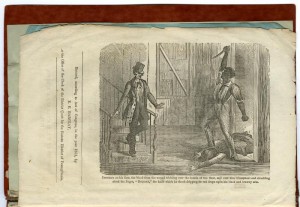
The riot is the climactic episode of The Killers, which describes it as having been triggered by a revenge plot created by Cromwell in cahoots with Don Jorge, the disaffected son of Hicks’s Cuban partner in the illegal slave-importation trade. Don Jorge’s father had been left to die by Hicks on an ill-fated slave-trading journey; Don Jorge befriends Cromwell and involves him in his own transatlantic slaving ventures, hardening him for the violent plot against Hicks to come. Hicks, reappearing after having gone underground for a few years, plots with Black Andy, the Black owner of a grog shop, to abduct Kate, who has caught his eye while working as an actress, for unnamed evil purposes. Thus exposing himself to the simultaneous revenge plots of Cromwell and Elijah, Hicks on the night of the riot finds himself imprisoned in the grog shop along with Kate. After Black Andy, defending his establishment, kills Cromwell, the Killers set the building on fire, ultimately killing Black Andy and Hicks—but not before Black Andy saves Kate from the flames. Don Jorge meets his end in the act of looting Hicks’s hidden hoard, shot by a gun in a booby-trapped box containing the records of Hicks’s illicit trade in slaves. His death leaves the money to be snapped up by Elijah, who uses the funds to carry himself and his half-sister Kate to safety in Panama and then California.
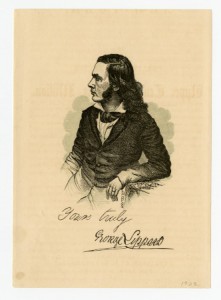
Four versions of George Lippard’s novella The Killers were published between late 1849 and 1851; only the last, under the title The Bank Director’s Son, bore Lippard’s name as author, as previous versions had been anonymous. Few copies of The Killers and its related titles are known to survive, but versions are held at the Historical Society of Pennsylvania and the Library Company of Philadelphia. Three of the versions are identical with the exception of their titles. A short pamphlet edition of the text, The Life and Adventures of Charles Anderson Chester (1849), features many of the same characters but lacks the Cuban dimension of the narrative, and reads more as an indictment of gang violence than an attack on the corrupt elite in finance and governance. There are no known reviews of the novella, so it is difficult to say anything concrete about its reception, but the fact that it was issued several times suggests at least modest popularity in Philadelphia.
The Killers reveals a Philadelphia torn by conflicts over race, class, ethnicity, and visions of the city itself. At the same time, its idealism and passages of historical description–woven into the narrative at a series of well-known Philadelphia sites—exhibit a sense of pride and the persistence of utopian hope in the city that characterize it from its earliest days. And while its sketches of Philadelphia and its denizens are cast in the chiaroscuro of the urban gothic, they, together with the various editions’ illustrations, provide a vivid sense of the city’s mid-century social topography.
Matt Cohen is Associate Professor of English at the University of Texas at Austin and a contributing editor at the online Walt Whitman Archive. With Edlie Wong, he edited Lippard’s The Killers with the University of Pennsylvania Press (2014). (Author information current at time of publication.”
Copyright 2015, Rutgers University
